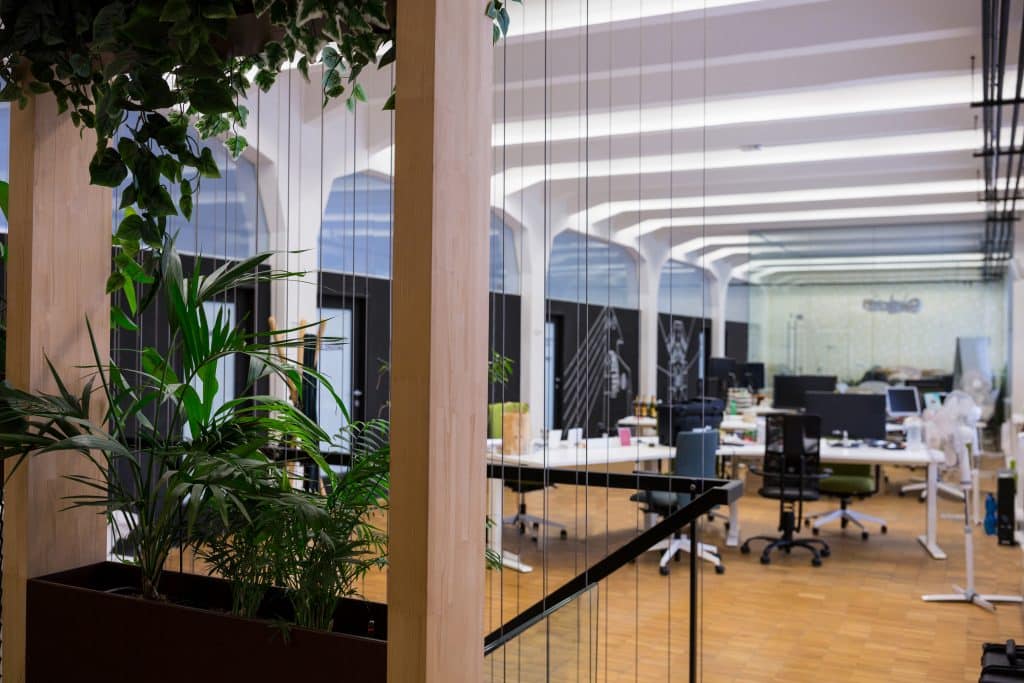Introduction
Guidelines for Meeting Room Space Per Person: In today’s corporate landscape, the design and size of meeting spaces are crucial for fostering effective collaboration and engagement. This article explores space planning for meeting rooms, emphasizing adequate space per person. We cover everything from general space recommendations to specific considerations for different room sizes and the impact of COVID-19 on space planning, aiming to provide actionable insights and guidelines to enhance productivity and comfort in meeting environments.
General Space Recommendations for Optimal Meeting Environments

Creating the perfect meeting environment requires a delicate balance between the physical space and the number of occupants. The key objective is to cultivate an atmosphere that not only facilitates collaboration and discussion but also ensures comfort and adherence to safety standards. Here are some essential guidelines to help you optimize the spatial dimensions of your meeting rooms:
- Adequate Space Allocation Per Attendee:
- To avoid a cramped setting and to ensure free movement, a standard guideline is to allocate approximately 25 to 30 square feet per person. This recommendation is essential for accommodating seating arrangements, free movement, and the placement of necessary equipment, contributing to a comfortable and productive meeting experience (Source: Facility Executive).
- Room Layout Considerations:
- The arrangement of the room plays a pivotal role in its functionality. Common layouts such as theater, classroom, and U-shaped setups each come with their own set of spatial requirements. Selecting the right configuration is critical for facilitating the type of interaction you aim to achieve in your meetings.
- Ergonomic Furniture Selection:
- Choosing the right furniture is crucial in maximizing space without sacrificing comfort. Opt for ergonomic options such as stackable chairs and foldable tables. These not only save space but also ensure that attendees are comfortably accommodated.
- Ensuring Accessibility:
- It’s imperative to design a space that is accessible to everyone, including individuals with disabilities. Following the ADA (Americans with Disabilities Act) guidelines can help create an inclusive environment where all participants can contribute effectively.
- Incorporating Technology Seamlessly:
- In today’s digital age, meetings often require technological support. Allocate space thoughtfully for projectors, screens, and other audio-visual equipment. It’s important to ensure that these tools are easily accessible and do not obstruct sightlines.
- Focus on Ventilation and Lighting:
- Good ventilation and appropriate lighting are crucial for maintaining an environment conducive to concentration and comfort. Ensure that HVAC systems are well-maintained and that lighting is adjustable to cater to different meeting requirements.
- Flexibility for Various Needs:
- If possible, choose a meeting space that offers flexibility. Rooms with modular furniture and movable walls can be easily reconfigured to suit varying group sizes and meeting objectives.
- Adherence to Local Regulations:
- Always keep local building codes and occupancy regulations in mind to ensure safety and legal compliance. This is not just a legal requirement but also a measure to guarantee the well-being of all attendees.
By implementing these general space recommendations, you can significantly enhance the productivity and satisfaction of meeting participants. Thoughtful space planning lays the foundation for successful and engaging interactions in any meeting environment.
Optimizing Space in Small to Medium-Sized Meeting Rooms for Maximum Efficiency

The art of space planning in small to medium-sized meeting rooms is crucial for ensuring both efficiency and comfort. Different room sizes have unique requirements that need careful consideration to foster a productive environment. Let’s explore these tailored recommendations:
- For Small Meeting Rooms (Up to 4 People):
- Space Allocation: Aim for at least 100 square feet. This size is optimal to offer comfort and ensure ease of movement within the room.
- Furniture Choice: Select compact, ergonomic furniture. Round or square tables can enhance interaction among attendees, making the most of the limited space.
- Technology Integration: Utilize wall-mounted screens and wireless technology. This approach not only saves valuable floor space but also enhances the overall meeting experience.
- For Medium-Sized Meeting Rooms (5 to 12 People):
- Space Allocation: The recommended guideline is 25 to 30 square feet per person. This translates to a total room size of approximately 250 to 360 square feet, allowing for comfortable movement and interaction.
- Furniture Arrangement: Opt for rectangular or oval tables, paired with ergonomic chairs. This setup is ideal for effective communication and comfort during prolonged meetings.
- Technology Setup: Ensure there’s enough room for central projectors or screens. Effective cable management is also crucial to maintain a safe and uncluttered space.
- Key Design Considerations:
- Acoustics: Prioritize good acoustics to prevent sound distortion and promote clear communication.
- Lighting: Utilize natural light where possible and provide adjustable lighting options to cater to various meeting needs.
- Ventilation: A well-ventilated room is essential for maintaining a fresh and comfortable atmosphere.
- Accessibility: Follow ADA guidelines to ensure the space is accessible to all attendees, emphasizing inclusivity.
- Compliance with Regulations:
- Adhering to local building codes and occupancy regulations is not just a legal mandate but also a step towards ensuring the safety and comfort of all participants (Source: American Institute of Architects).
By tailoring your meeting space according to its size and the expected number of attendees, you create an environment that is conducive to productive discussions and collaboration. Keeping these guidelines in mind, you’re on the right path to designing a functional and comfortable meeting space that caters to various needs.
Large Meeting Rooms and Conference Halls

- Adjustments in Space Planning for Larger Gatherings
Planning for large meeting rooms and conference halls demands a more nuanced approach to ensure that the space is optimized for higher occupancy while maintaining a conducive atmosphere for interaction and learning. Here are key considerations for space planning in larger settings:
- Space Allocation Per Person:
- The rule of thumb is to allocate at least 15 to 20 square feet per person to maintain a spacious environment. This helps in avoiding a cramped setting, thus promoting a more comfortable experience for attendees. (Source: International Facility Management Association)
- Room Layout:
- Experiment with various configurations like theater, classroom, or banquet style depending on the event requirements. The layout should promote good visibility and acoustics.
- Furniture Selection:
- Opt for lightweight, movable furniture to allow for easy reconfiguration. Modular furniture is ideal as it provides flexibility in accommodating different group sizes and meeting purposes.
- Technology Integration:
- Investing in advanced audio-visual equipment is crucial for effective presentations and interactions. Ensure that the technology is accessible and easy to operate, with clear sightlines for all attendees.
- Acoustics:
- With a larger crowd, good acoustics becomes paramount to ensure clear communication. Consider investing in soundproofing materials and high-quality audio systems.
- Ventilation and Lighting:
- Ensure the HVAC system is capable of maintaining a comfortable temperature for a larger crowd. Similarly, adequate lighting, both natural and artificial, is crucial for creating a conducive environment.
- Accessibility and Safety:
- Adhere to ADA guidelines and local building codes to ensure the safety and accessibility of the venue. This includes providing ample exits, wheelchair accessibility, and clear signage.
- Networking Spaces:
- Allocate areas for networking and breakout sessions. This promotes interaction and provides attendees with space to relax and discuss.
- On-site Support:
- Have a dedicated team to manage the setup, provide technical support, and ensure the smooth running of the event.
A well-thought-out space planning strategy is essential for large meeting rooms and conference halls to ensure a successful, engaging, and comfortable experience for all attendees. By following these guidelines, you are well on your way to creating an impactful and efficient large-scale meeting environment.
Conclusion

In conclusion, effective space planning for meeting rooms is a critical aspect of creating a productive and comfortable environment. Whether it’s a small meeting room or a large conference hall, understanding and implementing the right space per person is key to enhancing interaction quality and meeting effectiveness. The post-COVID-19 era has further underscored the importance of adaptable and safe meeting spaces.
Utilizing tools like the Cvent Room Size Calculator can aid in this endeavor (Source: Cvent Room Size Calculator). By drawing insights from successful real-world examples and continuously adapting to changing needs, organizations can create meeting spaces that not only meet but exceed the expectations of today’s dynamic corporate world.






